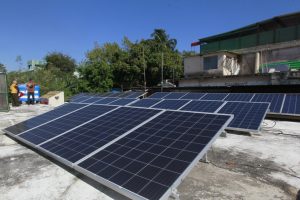Better Incentives Needed to Expand Solar Energy in Cuba
Latest World News
Solar panels line the rooftop of the home of Cuban entrepreneur Felix Morffi, in the municipality of Regla, Havana. Large consumers in the residential sector could find in the installation of solar panels a way to offset the amount of their energy bill through cogeneration for self-consumption or receive a payment for injecting clean energy into the national power grid. CREDIT: Jorge Luis Baños / IPS
By Luis Brizuela
HAVANA, Apr 17 2024 – With a bolder policy and flexible payment mechanisms, perhaps Alexis Rodríguez would have opted for solar panels for his home, instead of the portable generator that has made it possible for him to weather the frequent blackouts caused by Cuba’s recurrent energy crises.
“It’s a little noisy, the fuel is expensive, but I can tolerate one and solve the other. What is intolerable is for my family and I to spend nights and early mornings without electricity, without rest, suffering the heat and mosquitoes, and with the risk of the food in our fridge spoiling,” the barber, who lives in the eastern city of Holguín, told IPS.”Solar panels are the best, there is no fuel cost or noise. But they need to be sold with real incentives in order for more people to invest in them.” — Félix Morffi
Rodríguez shelled out 850 dollars a few months ago for a 2500 watt (W) gasoline-powered generator.
Marileydis Pérez, a homemaker in Batabanó south of Havana, received a 900 W generator from her son, who sent it from his home in the United States, “to run the fans, the television and turn on the lights on blackout nights.”
Pérez told IPS that although the government created a system of shifts for the sale of gasoline, “just five liters” for those who have registered generators, “I have only been able to buy it that way once in two years.” As a result, she resorts to the black market for gasoline.
Highly dependent on fuel imports, Cuba consumes more than eight million tons annually, of which almost 40 percent is covered by heavy domestic crude oil with a high sulfur content, used mainly in thermoelectric generation.
During the last five years, along with the deterioration of the domestic economic situation, the fall of the main sources of foreign currency and the tightening of the U.S. embargo, the authorities have faced increasing difficulties in meeting fuel demand.
An update of retail prices in the domestic market led to an increase of more than 400 percent in sales rates since Mar. 1.
The price of a liter of regular gasoline climbed from 25 to 132 Cuban pesos (equivalent to 1.10 dollars at the official rate). The same was true for regular diesel.
On the black market, a liter of regular gasoline costs 250 to 300 pesos, or 0.70 to 0.85 cents on the dollar, taking into account the exchange rate parallel to the government’s.
In this country of 11 million inhabitants, the average monthly salary is equivalent to about 40 dollars, which amounts to around 14 dollars in the informal reference market for a significant number of products, goods and services to which families have access in order to satisfy their basic needs.
The problems facing the energy supply have fuelled the importation of generators, as well as their sale on the black market. Government-owned stores that only take foreign currency also sell them at very high prices, far beyond the reach of most families.
An extension for the non-commercial import of up to two generators that produce more than 900 W has been in place since 2022.

A man starts up a gasoline-powered generator in the town of Batabanó, Mayabeque province, Cuba. The country’s energy problems have fuelled the importation of portable generators in the face of the frequent power cuts caused by the energy crisis in this Caribbean island nation. CREDIT: Luis Brizuela / IPS
Barriers
People who spoke to IPS expressed misgivings about the use of generators because they are noisy.
They pointed out that they are not always placed outside the houses or in ventilated rooms so that toxic combustion gases can escape and overheating can be avoided.
When IPS asked about the possibility of solar panels, Pérez said that “in addition to being very difficult to find outside Havana, they usually come without batteries, and if they are brought in, they cost half a million pesos (about 4200 dollars at the official exchange rate).”
When the public corporation Copextel, in charge of marketing and after-sales services, began to sell them in late 2021, “they were at 55,000 pesos” (2,300 dollars at the official exchange rate at the time), unaffordable for anyone who depends on their wages or on a pension,” said Rodríguez.
The price covered the purchase, transportation, installation and assembly of the panels and inverters by the company’s technicians.
“I spend less than 200 pesos on electricity a month. With what a solar panel costs I can pay for electricity for more than 20 years,” added Rodríguez.
Another hurdle for the expansion of solar power in the residential sector lies in the electricity tariff subsidy, which is charged in a devalued currency.
According to official figures, around six percent of the more than four million households in Cuba consume more than 500 kilowatt hours (kWh) per month. Above that threshold, the electricity tariff was increased by 25 percent since March to eliminate subsidies.
By installing solar panels, this segment of the population could find a way to offset the amount of the bill through cogeneration for self-consumption or receive a payment for injecting clean energy into the national grid.
“Those who have mainly purchased the panels are people with high incomes, especially owners of hostels and rental houses. It makes it possible for them to provide air conditioning in rooms for tourists and other services during the day,” Dunia Ulloa, commercial manager of Copextel’s branch in the Havana municipality of Plaza de la Revolución, told IPS.

Two people use the flashlight of a cell phone during a blackout in Havana. The government hopes that, from the current five percent, renewable sources will account for around 30 percent of electricity generation by 2030, in order to strengthen national energy security. CREDIT: Jorge Luis Baños / IPS
Projects and incentives still fall short
About 95 percent of Cuba’s electricity generation relies on fossil fuels, which include the natural gas produced with domestic oil, offshore oil rigs leased from Turkey, as well as diesel and fuel oil based generators and engines.
The government aims for renewables to account for around 30 percent of electricity generation by 2030, up from the current five percent.
With an installed capacity of 260 megawatts (MW), the solar parks installed in this Caribbean country represented two percent of annual electricity generation at the end of 2023, according to official data.
On Mar. 14, Minister of Energy and Mines Vicente de la O Levy reported that two contracts had been signed for the installation of 92 solar parks in all provinces, with a potential of 2000 MW.
By May 2025, the first of the 1,000 MW contracts must be fulfilled, and the second by 2028. Each one also has an additional 100 MW of storage capacity, he said.
Since 2014 Cuba has had a Policy for the Development of Renewable Energy Sources and their Efficient Use, and in 2019, Decree Law 345 established regulations to increase the share of renewables in the energy mix and gradually decrease consumption of fossil fuels.
In 2023 the Ministry of Finance and Prices issued Resolution 238 which doubled to six pesos (0.05 cents of a dollar at the official exchange rate) the price per kWh from renewable sources delivered to the national grid by independent producers in residential areas.
In addition, the regulations waive for up to eight years the tax on profits for economic actors that carry out electricity generation projects with renewable energy sources, and the customs tax on the importation of equipment to that end.
The results are not very encouraging, pending more attractive proposals for individuals to invest in green energies, in order to sell surplus electricity to the Cuban State.
The regulations do not exempt the import of these technologies for commercialization from customs duties: the cost is the same for materials or equipment, whether they are beneficial or detrimental to energy consumption.
Unlike other countries where people make a living from selling clean energy, in Cuba those who install solar panels essentially seek energy self-sufficiency, that is, to have electric power even during blackouts.
“Solar panels are the best, there is no fuel cost or noise. But they need to be sold with real incentives in order for more people to invest in them,” entrepreneur Félix Morffi, 86, a former mid-level technician in machinery and tool repair and a tenacious advocate of clean energy opportunities, told IPS.
A group of 36 solar panels on the roof of his house provide 10 kWh to support the work of his automotive repair shop, an autonomous enterprise built by Morffi next to his house in the municipality of Regla, in the Cuban capital.
After covering his household needs, the surplus electricity he produces goes to the national grid.
“An essential element is to provide credit. Not everyone has the money to buy the equipment. The other is to not get bogged down in red tape, because it scares people off. Banks must have people who deal only with this issue, who are trained, and who want to get things moving. If that happens, you will see how in the neighborhoods more and more people start to put up panels,” said Morffi.
In his view, “those who produce the most should be recognized, perhaps by giving them household appliances, increasing the rates paid to them for surplus energy or covering part of the investment. In the end, it is a gain for the country and reduces fuel expenses.”








